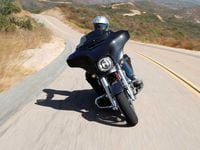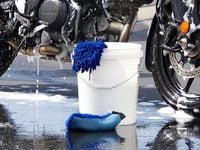COVID-19, also known as 2019 novel coronavirus, is quickly changing the way many of us proceed in public, and it’s important to have a game plan for when you go out in order to have the best chance of staying healthy and infection free. Motorcycle riders, even though they’re a formidable bunch unafraid of taking risks or facing danger, aren’t immune from the virus which is why we’ve put together a list of tips to help keep you safe and healthy as you ride through the storm.
Tip #1: Avoid Large Gatherings
We’re just coming into the riding season in many parts of the States and rallies, group rides, and meetups are a fantastic way to usher in another year of rides. This year, however, it would be wise to avoid these types of gatherings, if they haven’t already been canceled. The CDC states that the best way to avoid coronavirus is to “avoid being exposed” to the virus. So that means foregoing the club dinner or meeting after a ride and steering clear of popular hangouts that attract a lot of people.
Tip #2: Don’t Touch Your Face
So you just got back from a few hours on the road, you’ve stopped at a few places along the way, handled money, and opened a few public doors without your riding gloves on. You’re finally enjoying the fresh, sweet air on your head now that your helmet is off. If you’re like me, it would feel really good to rub your eyes or scratch that itch that started nagging you a few miles back. Try to avoid this, unless you are absolutely sure that your hands are fully sanitized. Grab a clean rag or handkerchief if you can instead, or find some hand soap and scrub for at least 20 seconds before you put those mitts on your face.
Tip #3: Manage Your Stress
For a lot of motorcyclists, riding is a form of stress management, but it’s optimal to have your stress levels under control before you get on the bike so you can minimize mistakes caused by inattention. So really try to get your head in the right place before you hit the road. Take a few minutes before you ride and take some deep breaths, stretch, make sure you’re well fed and well rested. Then, when you feel your focus is dialed and your body loose, start your ride.
Tip #4: Clean And Disinfect
Think about any commonly touched surfaces that may need to be addressed, such as any tools, your handlebars, or the inside of your helmet then clean and disinfect these surfaces. Cleaning gets the dirt and grime off, while disinfecting does the job of killing any lingering germs. The CDC recommends this two-step process in order to maximize the effectiveness of your sanitization practices.
Tip #5: Carry Sanitizer With You If Possible
If you have hand sanitizer at home that contains at least 60 percent alcohol, find a convenient way to carry some with you during a ride. It will come in handy if you stop anywhere along the way and touch any public surfaces, like a gas pump for instance.
Tip #6: Consider Keeping Your Gear In The Garage
For those who are doing out-and-back rides without any stops along the way, this tip may not be necessary, but if you’re stopping and interacting with others or making contact with high-traffic public surfaces, it may be wise to leave your gear in the garage. The CDC explains that it may be possible for coronavirus to be transmitted from contact with a contaminated surface, though it’s not considered the primary means of transmission. At this time it’s also thought that coronavirus has poor survivability on surfaces, so this precaution is a better-safe-than-sorry recommendation for those who have high-risk family members at home, such as the elderly or those with chronic medical conditions like heart or lung disease.
Tip #7: If You Feel Sick Or Are Worried That You’ve Been Exposed, Stay Home
If you have a bit of a cough or other mild flu-like symptoms, stay home and give yourself time to rest. In other circumstances feeling a bit under the weather might not be reason enough to forego a ride, but with coronavirus it’s to your benefit and the benefit of your community to hold off. This recommendation also goes for anyone who is worried they may have been exposed, since symptoms don’t show up right away and some people may be asymptomatic. The CDC indicates that symptoms can show anywhere between two and 14 days after exposure, and that the range and severity of symptoms varies.
Above all else, be safe out there, exercise your best judgment and follow any additional recommendations provided from your local health authorities.














/cloudfront-us-east-1.images.arcpublishing.com/octane/TNOU5DNE2BC57MFPMGN2EIDXAM.jpg)
/cloudfront-us-east-1.images.arcpublishing.com/octane/GTCXACQGJ5HAPDTGWUQKDEH44E.jpg)
/cloudfront-us-east-1.images.arcpublishing.com/octane/S35YGSEMEZB4BLTDJTSZPF4GLA.jpg)
/cloudfront-us-east-1.images.arcpublishing.com/octane/5UOT6HPX2JFMRJAX6EH45AR4MQ.jpg)
/cloudfront-us-east-1.images.arcpublishing.com/octane/OKWOJWAKP5EP3OACCRRWPCIX2Q.jpg)
/cloudfront-us-east-1.images.arcpublishing.com/octane/2WF3SCE3NFBQXLDNJM7KMXA45E.jpg)
/cloudfront-us-east-1.images.arcpublishing.com/octane/G4MG6OUCJNBSHIS2MVVOTPX65E.jpg)
/cloudfront-us-east-1.images.arcpublishing.com/octane/IIGGWFOTOJGB7DB6DGBXCCMTDY.jpg)
/cloudfront-us-east-1.images.arcpublishing.com/octane/QSTCM6AVEZA5JJBUXNIQ3DSOF4.jpg)
/cloudfront-us-east-1.images.arcpublishing.com/octane/U4I7G625B5DMLF2DVIJDFZVV6M.jpg)
/cloudfront-us-east-1.images.arcpublishing.com/octane/B6XD6LS6IVCQPIU6HXDJSM3FHY.jpg)
/cloudfront-us-east-1.images.arcpublishing.com/octane/ICL63FEDDRDTTMINYICCEYGMDA.jpg)
/cloudfront-us-east-1.images.arcpublishing.com/octane/FCGZHQXRBZFLBAPC5SDIQLVF4I.jpg)
/cloudfront-us-east-1.images.arcpublishing.com/octane/WNOB6LDOIFFHJKPSVIWDYUGOPM.jpg)

/cloudfront-us-east-1.images.arcpublishing.com/octane/X33NU3E525ECRHXLNUJN2FTRKI.jpg)
/cloudfront-us-east-1.images.arcpublishing.com/octane/6KKT5NNL2JAVBOXMZYS5ZO76YA.jpg)
/cloudfront-us-east-1.images.arcpublishing.com/octane/J5RKG5O455GMPGQRF2OG6LRT7A.jpg)
/cloudfront-us-east-1.images.arcpublishing.com/octane/GX2CIZKQVRH2TATDM26KFG2DAE.jpg)
/cloudfront-us-east-1.images.arcpublishing.com/octane/ZWIDYSAKQZHD5BHREMQILXJCGM.jpg)
/cloudfront-us-east-1.images.arcpublishing.com/octane/CYUHJZCTSJCH3MRAQEIKXK7SCQ.jpg)
/cloudfront-us-east-1.images.arcpublishing.com/octane/LKOFINY56FCXJCANJ5M7ZDQUBY.jpg)
/cloudfront-us-east-1.images.arcpublishing.com/octane/4NBPDACMWJH63JQYJVK3QRBDZI.jpg)
/cloudfront-us-east-1.images.arcpublishing.com/octane/KKHQHRR3FJGX7H2IPU6RALMWG4.jpg)